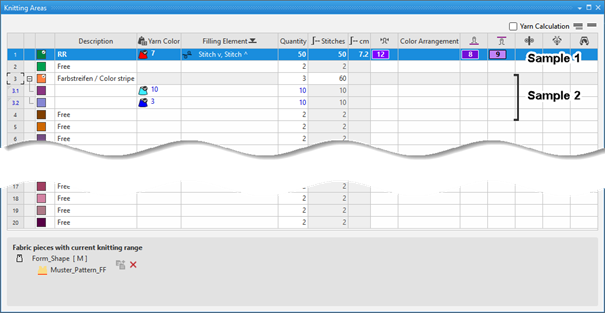Step by Step to 'Pattern-11'
- A pattern project with one pattern and the desired settings is created.
- 1
- To create a project-related lined shape, select the
 Shapes tab in the tool window.
Shapes tab in the tool window.
- or -
Load an existing shape. - 2
- Open the context menu with RMB and select Create New Shape of Size M....
- The New Lined Shape tool window is opened.
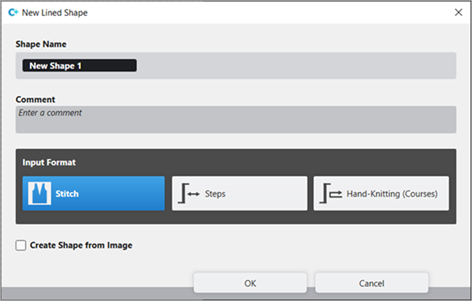
- 3
- Make the desired entries:
- Shape Name: Any
- Input Format: Stitch
- 4
- Confirm with the OK key.
- The new lined shape (basic shape) is graphically displayed in the
 Shapes tab and in a new document window
Shapes tab and in a new document window  as rectangle.
as rectangle.
 : Default attributes are used for the shape edges of the lined shape.
: Default attributes are used for the shape edges of the lined shape.
Menu File -> Options -> Lined Shape -> Options for New Lined Shape
- 5
- Open the docked line table by LMB in the
 document window.
document window.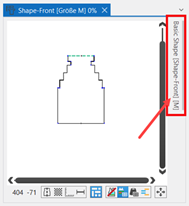
- or -
Use the graphic displayed in the document window.
document window. - The table Lined Shape with the values of the rectangular shape appears.

 : The method (table or graphic) to create a project-related lined shape is freely eligible, since the views are always updated simultaneously.
: The method (table or graphic) to create a project-related lined shape is freely eligible, since the views are always updated simultaneously.
- 6
- Insert new shape lines in the table and enter the desired values for the basic shape.
- Standard attributes from configuration are assigned to those shape lines.
- 7
- Insert new shape lines in the table and enter the desired values for the Neckline shape element.
- Standard attributes from configuration are assigned to those shape lines.
Example: Lined shape for Pattern-11
|
Basic Shape: Front |
|
|
|
|
|
Neckline Shape Element (V-neck) |
|
|
Rules for creating a shape for the knitting mode SJ:
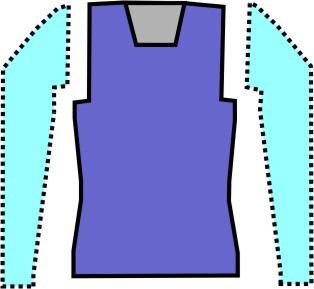
Example Front:
|
Shape Attributes |
Rules / possible settings |
|---|---|
|
Knitting Mode: |
Single Jersey |
|
Step width of widening |
1 needle (stitch) per knitting row |
|
Step height of widening |
As desired |
|
Quantity of rows without shape modification |
As desired |
|
Step width when narrowing |
1 - 3 needles (stitches) |
|
Step height when narrowing |
As desired |
|
Fading-out Width |
As desired |
|
Knitting mode for fading-out |
Front Stitch with Transfer |
|
Binding-off width: |
Stepping > 3 stitches |
|
Binding-off methods |
Binding-off, Structure, Single Jersey
|
- 8
- Allocate the desired attributes to the shape lines of the basic shape and of the neckline shape element.
- 9
- Open the graphic of the basic shape in the
 xx document window.
xx document window. - 10
- Click the
 Knitting Ranges button under Parameter in the Shape Editing ribbon.
Knitting Ranges button under Parameter in the Shape Editing ribbon. - The Knitting Ranges tool window appears.
|
| ||
|
1 |
Colors |
Display color of the knitting range in the lined shape |
|
2 |
Description |
Definition of a knitting range |
|
3 |
|
Allocation of: |
|
4 |
Filling Element |
Selection of a knitting element / needle action / structure / pattern element to fill the knitting range |
|
5 |
Quantity |
Height of the knitting range by stitch rows |
|
6 |
|
Display of the total height by stitches |
|
7 |
|
Display of the total height by cm
|
|
8 |
|
Assignment of a stitch density from the stitch density tool window |
|
9 |
Color Arrangement |
Assignment of Color Arrangements |
|
10 |
|
Assignment of a stitch length for the front needle bed |
|
|
Assignation of a stitch length for the rear needle bed | |
|
|
Assignment of a take-down value | |
|
|
Assignment of a auxiliary take-down value | |
|
|
Assignment of a machine speed | |
|
11 |
List of the shapes (fabric pieces), where the selected knitting range is in use.
| |
- 11
- Create the desired knitting ranges in the
 Knitting Ranges tool window.
Knitting Ranges tool window.
- Example 1:
- Knitting Range DJ
- By another yarn color, structure, stitch density and stitch lengths
- Example 2:
- Knitting range of color stripes
- Color stripes of two yarn colors
 : You have to create several sub-rows per main row corresponding to the knitting ranges with different specifications.
: You have to create several sub-rows per main row corresponding to the knitting ranges with different specifications.
Creating Knitting Ranges:
- Lined shape is created.
- Lined shape appears in the
 xx document window.
xx document window. - The
 Knitting Ranges tool window is open.
Knitting Ranges tool window is open.
- 1
- Make the desired definitions in the desired, undefined (free) table row:
- Example 1:
- Knitting Range DJ
- By another yarn color, structure, stitch density and stitch lengths
- Example 2:
- Knitting range of color stripes
- For color stripes of two yarn colors
 : You have to create several sub-rows per main row corresponding to the knitting ranges with different specifications.
: You have to create several sub-rows per main row corresponding to the knitting ranges with different specifications.
|
|
Creating sub-rows for an existing main row:
- 2
- Select the desired main row.
- 3
- Open the context menu with RMB and select Add Sub-row.
- 4
- Make the desired specifications in the sub-row.
- 5
- Create more sub-rows if necessary.
- 12
- Add the created knitting ranges to a shape point of the basic shape.
Enter the created knitting ranges into the shape and position it:
- Shape is created as lined shape.
- The knitting ranges are available in the
 Knitting Ranges tool window.
Knitting Ranges tool window. - Lined shape is opened in the
 xx document window.
xx document window.
- 1
- Select the desired shape point by the LMB to which you want to assign the knitting range.
- 2
- Open the context menu and select Assign Knitting Range.
- List of the knitting ranges appears to select one.
Multiple selection is possible. - 3
- Select the desired knitting range.
- The knitting range appears in the assigned color at the the shape line point of the lined shape.
|
|
Enable the view of the knitting ranges in the |
|
|
Disable the view of the knitting ranges in the |
|
|
Display of the knitting ranges in the |
- 4
- Position the inserted knitting range.
|
| ||
|
1 |
Selecting knitting ranges to replace the inserted knitting range. | |
|
2 |
Specify the Distance in Stitches in relation to the shape line point | |
|
3 |
Insert Knitting Range Downwards | |
|
|
Knitting range will be inserted above the shape line point | |
|
|
Knitting range will be inserted below the shape line point | |
If you insert several knitting ranges, they may overlap each other.
You can specify the order of overlapping of the knitting ranges and with it, the motif in the pattern.
- Several knitting ranges are inserted into the shape.
- These knitting ranges are overlapping.
- 1
- Select the desired knitting range.
- 2
- Select the desired function under Arrange Objects in the Shape EditingShape Editing ribbon
- or -
In the xx document window, in the selected knitting area, select the Rearrangecontext menu with desired function.
xx document window, in the selected knitting area, select the Rearrangecontext menu with desired function.
|
|
Bring to Front |
The selected knitting area / shape element is positioned in the foreground (covering) in relation to all other knitting areas / shape elements. |
|
|
Send to Back |
The selected knitting area / shape element is positioned in the background (overlapped) in relation to all other knitting areas / shape elements. |
|
|
Bring Forward |
The selected knitting area / shape element is positioned one layer to the front. |
|
|
Send Backward |
The selected knitting area / shape element is positioned one layer to the back. |
- 13
- In the Shapes tool window select the created shape with LMB.
- 14
- Open the context menu -> Position Shape -> select Pattern name.
- The shape is floating in the selected basic pattern.
- 15
- To position the shape, enable the
 button of the document window.
button of the document window. - 16
- Start the
 Technical
Processing .
Technical
Processing .
With the button, show Symbol view after technical processing.
button, show Symbol view after technical processing. - 17
- Generate
 Sintral.
Sintral. - 18
- Start the
 Sintral Check.
Sintral Check. - 19
-
 Extract the knitting program.
Extract the knitting program. - A program for the knitting machine will be created: CMS530.Pattern11.zip.
- 20
- Load knitting program into the machine.
 : The extracted file CMS530.Pattern-11.zip can be loaded onto the machine with an USB stick or via Ethernet.
: The extracted file CMS530.Pattern-11.zip can be loaded onto the machine with an USB stick or via Ethernet.


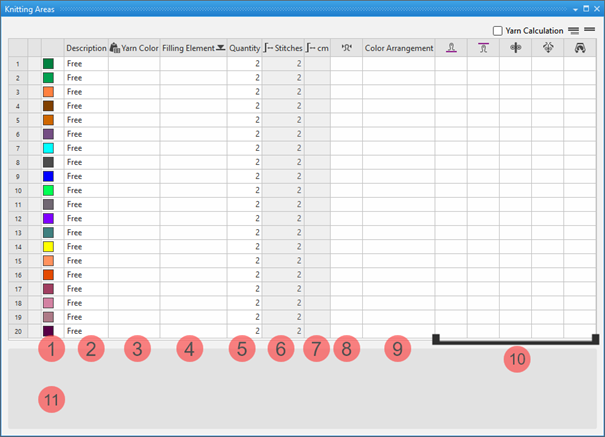









 button.
button.